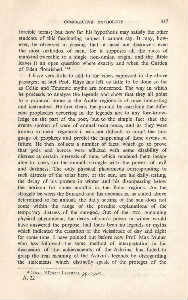Page 556 - Lokmanya Tilak Samagra (khand 2)
P. 556
COMPARATINE MYTHOLOGY 337
forcible terms; but how far his hypothesis may satisfy the other
students of this fascinating subject I cannot say. It may, how-
ever, be observed in passing that it need not disconcert even
the most orthodox of men, for it supposes all the races of
mankind traceable to a single non-simian origin, and the Bible
leaves it an open question where exactly and when the Garden
of Eden flourished. "*
I have very little to add to the views expressed in the above
passages; in fact Prof. Rhys has left us little to be done so far
as Celtic and Teutonic myths are concerned. The way in which
he proceeds to analyze the legends and show that they all point
to a primeval home in the Arctic regions is at once interesting
and instructive. He first clears the ground by ascribing the diffe-
rent prophecies occurring in the legends not to any fore-know-
ledge on the part of the poet, but to the simple fact that the
events spoken of were of annual occurrence, and as they were
known to recur regularly it was not difficult to adopt the lan-
guage of prophecy and predict the happening of these events in
future. He then collects a number of facts which go to prove
that gods and heroes were afflicted with some disability of
distress at certain intervals of time, which rendered them incap-
able to carry on the annual struggle with the powers of evil
and darkness. The only physical phenomena corresponding to
such distress of the solar hero, or the sun, are his daily setting,
the decay of his powers in winter and his disappearing below
the horizon for some months in the Polar regions. As the
struggle between the Sun-god and his enemies is, as stated above
determined to be annual, the daily setting of the sun does not
come within the range of the possible explanations of the
temporary distress of the sun-god. Out of the two remaining
physical phenomena, the decay of sun's power in winter would
have answered the purpose, had there been no legends or myths
which indicated the cessation of the vicissitude of day and night
for some time. I have pointed out before how Prof. Max Muller
who has followed the same method of interpretation in his
discussion of the achievements of the Ashvins, has failed to
grasp the real meaning of the Ashvin's legends by disregarding
the statements which distinctly speak of the proteges of the
* Rhys' Hibbert Lectures, pp. 636-7.
A. 22

